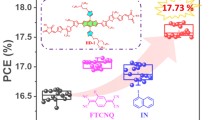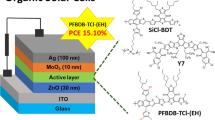Abstract
The ternary strategy for incorporating multiple photon-sensitive components into a single junction has emerged as an effective method for optimizing the nanoscale morphology and improving the device performance of organic solar cells (OSCs). In this study, efficient and stable ternary OSCs were achieved by introducing the small-molecule dye (5E,5′E)-5,5′-(4′,4″-(1,2-diphenylethene-1,2-diyl)bis(biphenyl-4′,4-diyl))bis(methan-1-yl-1-ylidene)bis(3-ethyl-2-thioxothia zolidin-4-one) (BTPE-Rn) into poly[4,8-bis(5-(2-ethylhexyl)thiophen-2-yl)benzo[1,2-b:4,5-b′]dithiophene-co-3-fluorothieno[3,4-b]thiophene-2-carboxylate] (PTB7-Th):[6,6]-phenyl C71 butyric acid methyl ester (PC71BM) blend films processed using a 1,8-diiodooctane (DIO)-free solvent. The incorporation of BTPE-Rn enhanced the short-circuit current density and fill factor of the ternary OSCs compared with those of binary OSCs. An investigation of the optical, electronic, and morphological properties of the ternary blends indicated that the third component of BTPE-Rn not only promoted the photon utilization of blends through the energy-transfer process but also improved the electron mobility of the blends owing to the fullerene-rich nanophase optimization. More importantly, this ternary strategy of utilizing a small-molecule dye to replace the photounstable DIO additive enhanced the operational stability of the OSCs.

Similar content being viewed by others
References
Savoie, B. M.; Dunaisky, S.; Marks, T. J.; Ratner, M. A. The scope and limitations of ternary blend organic photovoltaics. Adv. Energy Mater. 2015, 5, 1400891.
Ameri, T.; Khoram, P.; Min, J.; Brabec, C. J. Organic ternary solar cells: A review. Adv. Mater. 2013, 25, 4245–4266.
Lu, L. Y.; Kelly, M. A.; You, W.; Yu, L. P. Status and prospects for ternary organic photovoltaics. Nat. Photonics 2015, 9, 491–500.
Koppe, M.; Egelhaaf, H.-J.; Dennler, G.; Scharber, M. C.; Brabec, C. J.; Schilinsky, P.; Hoth, C. N. Near IR sensitization of organic bulk heterojunction solar cells: Towards optimization of the spectral response of organic solar cells. Adv. Funct. Mater. 2010, 20, 338–346.
Huang, J.-H.; Velusamy, M.; Ho, K.-C.; Lin, J.-T.; Chu, C.-W. A ternary cascade structure enhances the efficiency of polymer solar cells. J. Mater. Chem. 2010, 20, 2820–2825.
Lu, L. Y.; Xu, T.; Chen, W.; Landry, E. S.; Yu, L. P. Ternary blend polymer solar cells with enhanced power conversion efficiency. Nat. Photonics 2014, 8, 716–722.
Ameri, T.; Min, J.; Li, N.; Machui, F.; Baran, D.; Forster, M.; Schottler, K. J.; Dolfen, D.; Scherf, U.; Brabec, C. J. Performance enhancement of the P3HT/PCBM solar cells through NIR sensitization using a small-bandgap polymer. Adv. Energy Mater. 2012, 2, 1198–1202.
Zhang, S. H.; Zuo, L. J.; Chen, J. H.; Zhang, Z. Q.; Mai, J. Q.; Lau, T.-K.; Lu, X. H.; Shi, M. M.; Chen, H. Z. Improved photon-to-electron response of ternary blend organic solar cells with a low band gap polymer sensitizer and interfacial modification. J. Mater. Chem. A 2016, 4, 1702–1707.
Liu, T.; Huo, L. J.; Sun, X. B.; Fan, B. B.; Cai, Y. H.; Kim, T.; Kim, J. Y.; Choi, H.; Sun, Y. M. Ternary organic solar cells based on two highly efficient polymer donors with enhanced power conversion efficiency. Adv. Energy Mater. 2016, 6, 1502109.
Liu, W. Q.; Shi, H. Q.; Fu, W. F.; Zuo, L. J.; Wang, L.; Chen, H. Z. Efficient ternary blend polymer solar cells with a bipolar diketopyrrolopyrrole small molecule as cascade material. Org. Electron. 2015, 25, 219–224.
Zhong, C. M.; Choi, H.; Kim, J. Y.; Woo, H. Y.; Nguyen, T. L.; Huang, F.; Cao, Y.; Heeger, A. J. Ultrafast charge transfer in operating bulk heterojunction solar cells. Adv. Mater. 2015, 27, 2036–2041.
Cheng, P.; Li, Y. F.; Zhan, X. W. Efficient ternary blend polymer solar cells with indene-C60 bisadduct as an electroncascade acceptor. Energy Environ. Sci. 2014, 7, 2005–2011.
Khlyabich, P. P.; Burkhart, B.; Thompson, B. C. Efficient ternary blend bulk heterojunction solar cells with tunable open-circuit voltage. J. Am. Chem. Soc. 2011, 133, 14534–14537.
Khlyabich, P. P.; Burkhart, B.; Thompson, B. C. Compositional dependence of the open-circuit voltage in ternary blend bulk heterojunction solar cells based on two donor polymers. J. Am. Chem. Soc. 2012, 134, 9074–9077.
Lu, L. Y.; Chen, W.; Xu, T.; Yu, L. P. High-performance ternary blend polymer solar cells involving both energy transfer and hole relay processes. Nat. Commun. 2015, 6, 7327.
Gupta, V.; Bharti, V.; Kumar, M.; Chand, S.; Heeger, A. J. Polymer–polymer förster resonance energy transfer significantly boosts the power conversion efficiency of bulk-heterojunction solar cells. Adv. Mate. 2015, 27, 4398–4404.
Benten, H.; Nishida, T.; Mori, D.; Xu, H. J.; Ohkita, H.; Ito, S. High-performance ternary blend all-polymer solar cells with complementary absorption bands from visible to nearinfrared wavelengths. Energy Environ. Sci. 2016, 9, 135–140.
Cheng, P.; Yan, C. Q.; Wu, Y.; Wang, J. Y.; Qin, M.; An, Q. S.; Cao, J. M.; Huo, L. J.; Zhang, F. J.; Ding, L. M. et al. Alloy acceptor: Superior alternative to pcbm toward efficient and stable organic solar cells. Adv. Mater. 2016, 28, 8021–8028.
Street, R. A.; Khlyabich, P. P.; Rudenko, A. E.; Thompson, B. C. Electronic states in dilute ternary blend organic bulk heterojunction solar cells. J. Phys. Chem. C 2014, 118, 26569–26576.
Street, R. A.; Davies, D.; Khlyabich, P. P.; Burkhart, B.; Thompson, B. C. Origin of the tunable open-circuit voltage in ternary blend bulk heterojunction organic solar cells. J. Am. Chem. Soc. 2013, 135, 986–989.
Yang, L. Q.; Zhou, H. X.; Price, S. C.; You, W. Parallel-like bulk heterojunction polymer solar cells. J. Am. Chem. Soc. 2012, 134, 5432–5435.
Zhang, J. Q.; Zhang, Y. J.; Fang, J.; Lu, K.; Wang, Z. Y.; Ma, W.; Wei, Z. X. Conjugated polymer–small molecule alloy leads to high efficient ternary organic solar cells. J. Am. Chem. Soc. 2015, 137, 8176–8183.
Zhang, Y. J.; Deng, D.; Lu, K.; Zhang, J. Q.; Xia, B. Z.; Zhao, Y. F.; Fang, J.; Wei, Z. X. Synergistic effect of polymer and small molecules for high-performance ternary organic solar cells. Adv. Mater. 2015, 27, 1071–1076.
Goh, T.; Huang, J.-S.; Yager, K. G.; Sfeir, M. Y.; Nam, C.-Y.; Tong, X.; Guard, L. M.; Melvin, P. R.; Antonio, F.; Bartolome, B. G. et al. Quaternary organic solar cells enhanced by cocrystalline squaraines with power conversion efficiencies >10%. Adv. Energy Mater. 2016, 6, 1600660.
Gasparini, N.; Jiao, X. C.; Heumueller, T.; Baran, D.; Matt, G. J.; Fladischer, S.; Spiecker, E.; Ade, H.; Brabec, C. J.; Ameri, T. Designing ternary blend bulk heterojunction solar cells with reduced carrier recombination and a fill factor of 77%. Nat. Energy. 2016, 1, 16118.
Nian, L.; Gao, K.; Liu, F.; Kan, Y. Y.; Jiang, X. F.; Liu, L. L.; Xie, Z. Q.; Peng, X. B.; Russell, T. P.; Ma, Y. G. 11% efficient ternary organic solar cells with high composition tolerance via integrated near-IR sensitization and interface engineering. Adv. Mater. 2016, 28, 8184–8190.
Lu, H.; Zhang, J. C.; Chen, J. Y.; Liu, Q.; Gong, X.; Feng, S. Y.; Xu, X. J.; Ma, W.; Bo, Z. S. Ternary-blend polymer solar cells combining fullerene and nonfullerene acceptors to synergistically boost the photovoltaic performance. Adv. Mater. 2016, 28, 9559–9566.
Zhang, G. C.; Zhang, K.; Yin, Q. W.; Jiang, X.-F.; Wang, Z. Y.; Xin, J. M.; Ma, W.; Yan, H.; Huang, F.; Cao, Y. High-performance ternary organic solar cell enabled by a thick active layer containing a liquid crystalline small molecule donor. J. Am. Chem. Soc. 2017, 139, 2387–2395.
Khlyabich, P. P.; Rudenko, A. E.; Street, R. A.; Thompson, B. C. Influence of polymer compatibility on the open-circuit voltage in ternary blend bulk heterojunction solar cells. ACS Appl. Mater. Interfaces 2014, 6, 9913–9919.
Yang, Y.; Chen, W.; Dou, L. T.; Chang, W.-H.; Duan, H.-S.; Bob, B.; Li, G.; Yang, Y. High-performance multiple-donor bulk heterojunction solar cells. Nat. Photonics 2015, 9, 190–198.
Gasparini, N.; Salvador, M.; Fladischer, S.; Katsouras, A.; Avgeropoulos, A.; Spiecker, E.; Chochos, C. L.; Brabec, C. J.; Ameri, T. An alternative strategy to adjust the recombination mechanism of organic photovoltaics by implementing ternary compounds. Adv. Energy Mater. 2015, 5, 1501527.
Mai, J. Q.; Lau, T.-K.; Li, J.; Peng, S.-H.; Hsu, C.-S.; Jeng, U. S.; Zeng, J. R.; Zhao, N.; Xiao, X. D.; Lu, X. H. Understanding morphology compatibility for high-performance ternary organic solar cells. Chem. Mater. 2016, 28, 6186–6195.
Lee, T. H.; Uddin, M. A.; Zhong, C. M.; Ko, S.-J.; Walker, B.; Kim, T.; Yoon, Y. J.; Park, S. Y.; Heeger, A. J.; Woo, H. Y. et al. Investigation of charge carrier behavior in high performance ternary blend polymer solar cells. Adv. Energy Mater. 2016, 6, 1600637.
Jørgensen, M.; Norrman, K.; Gevorgyan, S. A.; Tromholt, T.; Andreasen, B.; Krebs, F. C. Stability of polymer solar cells. Adv. Mater. 2012, 24, 580–612.
Jørgensen, M.; Norrman, K.; Krebs, F. C. Stability/degradation of polymer solar cells. Sol. Energy Mater. Sol. Cells 2008, 92, 686–714.
Williams, G.; Wang, Q.; Aziz, H. The photo-stability of polymer solar cells: Contact photo-degradation and the benefits of interfacial layers. Adv. Funct. Mater. 2013, 23, 2239–2247.
Cao, H. Q.; He, W. D.; Mao, Y. W.; Lin, X.; Ishikawa, K.; Dickerson, J. H.; Hess, W. P. Recent progress in degradation and stabilization of organic solar cells. J. Power Sources 2014, 264, 168–183.
Chao, Y.-H.; Huang, Y.-Y.; Chang, J.-Y.; Peng, S.-H.; Tu, W.-Y.; Cheng, Y.-J.; Hou, J. H.; Hsu, C.-S. A crosslinked fullerene matrix doped with an ionic fullerene as a cathodic buffer layer toward high-performance and thermally stable polymer and organic metallohalide perovskite solar cells. J. Mater. Chem. A 2015, 3, 20382–20388.
Yin, Z. G.; Zheng, Q. D.; Chen, S.-C.; Li, J. X.; Cai, D. D.; Ma, Y. L.; Wei, J. J. Solution-derived poly(ethylene glycol)- TiOx nanocomposite film as a universal cathode buffer layer for enhancing efficiency and stability of polymer solar cells. Nano Res. 2015, 8, 456–468.
Kim, W.; Kim, J. K.; Kim, E.; Ahn, T. K.; Wang, D. H.; Park, J. H. Conflicted effects of a solvent additive on PTB7: PC71BM bulk heterojunction solar cells. J. Phys. Chem. C 2015, 119, 5954–5961.
Pearson, A. J.; Hopkinson, P. E.; Couderc, E.; Domanski, K.; Abdi-Jalebi, M.; Greenham, N. C. Critical light instability in CB/DIO processed PBDTTT-EFT:PC71BM organic photovoltaic devices. Org. Electron. 2016, 30, 225–236.
Tremolet de Villers, B. J.; O’Hara, K. A.; Ostrowski, D. P.; Biddle, P. H.; Shaheen, S. E.; Chabinyc, M. L.; Olson, D. C.; Kopidakis, N. Removal of residual diiodooctane improves photostability of high-performance organic solar cell polymers. Chem. Mater. 2016, 28, 876–884.
Lee, S.; Kong, J.; Lee, K. Air-stable organic solar cells using an iodine-free solvent additive. Adv. Energy Mater. 2016, 6, 1600970.
Hong, Y. N.; Lam, J. W. Y.; Tang, B. Z. Aggregation-induced emission: Phenomenon, mechanism and applications. Chem. Commun. 2009, 4332–4353.
Murgatroyd, P. N. Theory of space-charge-limited current enhanced by frenkel effect. J. Phys. D: Appl. Phys. 1970, 3, 151–156.
Acknowledgements
The authors thank the financial support from the National Basic Research Program of China (No. 2014CB643503). The work was also partly supported by the National Natural Science Foundation of China (Nos. 21474088 and 21674093). F. L. and C. Z. L. thank the support from Young 1000 Talents Global Recruitment Program of China. T. P. R. were supported by the U.S. Office of Naval Research under contract N00014-15-1-2244. Portions of this research were carried out at beamline 7.3.3 and 11.0.1.2 at the Advanced Light Source, Molecular Foundry, and National Center for Electron Microscopy, Lawrence Berkeley National Laboratory, which was supported by the DOE, Office of Science, and Office of Basic Energy Sciences.
Author information
Authors and Affiliations
Corresponding authors
Electronic supplementary material
12274_2017_1589_MOESM1_ESM.pdf
Efficient and 1,8-diiodooctane-free ternary organic solar cells fabricated via nanoscale morphology tuning using small-molecule dye additive
Rights and permissions
About this article
Cite this article
Zhang, S., Shah, M.N., Liu, F. et al. Efficient and 1,8-diiodooctane-free ternary organic solar cells fabricated via nanoscale morphology tuning using small-molecule dye additive. Nano Res. 10, 3765–3774 (2017). https://doi.org/10.1007/s12274-017-1589-0
Received:
Revised:
Accepted:
Published:
Issue Date:
DOI: https://doi.org/10.1007/s12274-017-1589-0




